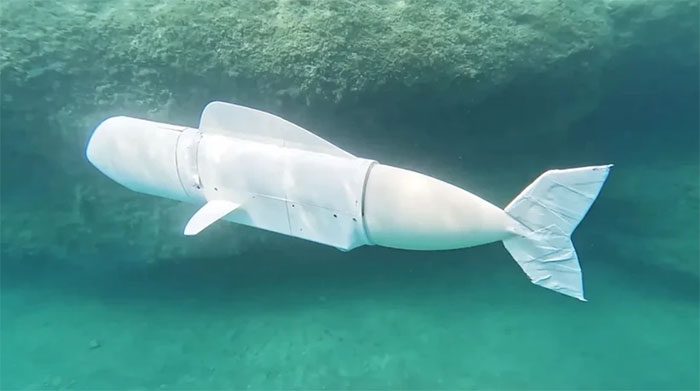A new robot named “Eve” is currently under development, designed to resemble a fish with a silicon tail that can move like “the real thing.” It is set to perform a unique mission.
Located about 400 kilometers off the nearest coast, engineering students at the Swiss Federal Institute of Technology Zurich (ETH Zurich) are diligently researching and developing an advanced line of robots that could revolutionize our understanding of the ocean.
The new robot, named “Eve”, resembles a fish and features a silicon tail that moves like “the real thing.” Pumps housed within the robot provide the energy required for its movement.

Eve is a fish-shaped robot with movement powered by its tail. (Source: CNN).
This “fish” is currently being tested by the SURF-eDNA group (students at ETH Zurich) in Lake Zurich. They have spent two years creating a series of fish-like robots, with Eve being the latest model.
“With Eve looking just like a real fish, we will be able to conduct research with minimal impact on the ecosystems we are studying,” shared Master’s student Dennis Baumann with CNN. He added that the fish-like design will help ensure that marine creatures or other fish are not startled by its presence.
In addition to its fish-like appearance, Eve is equipped with a camera for filming and sonar technology to help it navigate around obstacles during movement. This robotic fish also includes a filter to collect environmental DNA (eDNA) from the waters it swims through, which can then be analyzed to determine which species inhabit the area.
“All living organisms in their environment shed DNA. Therefore, there will be DNA floating around that we can collect,” researcher Martina Lüthi from ETH Zurich told CNN.
The students hope that Eve can provide scientists with a clearer picture of the ocean and its inhabitants. Despite covering more than 70% of the Earth’s surface, much of what lies beneath the ocean remains a mystery.
Today, tools such as Autonomous Underwater Vehicles (AUVs) and remotely operated vehicles are increasingly used to explore the ocean and learn more about underwater environments.
For example, the California-based startup Aquaai has developed drone-like devices resembling clownfish that can gather underwater data such as oxygen levels, salinity, and pH. Notably, last year, one of the company’s autonomous devices recorded footage of snailfish swimming at a record depth of 8,300 meters.
The use of eDNA to monitor biodiversity is becoming more common. However, some scientists still prefer traditional methods of collecting DNA, such as taking water samples from areas of interest.
In the future, more advanced tools capable of conducting detailed environmental research will play a crucial role in protecting the Earth’s oceans. This is especially important now, as ocean habitats face unprecedented threats from climate change, overfishing, and other harmful human activities.
“We aim to create a reliable tool for biologists,” Dennis Baumann said. He also expressed hope that one day he could share his technology with the world, allowing any scientist who wishes to utilize it to have access. “Perhaps we can prevent many species from teetering on the brink of extinction,” he shared.




















































